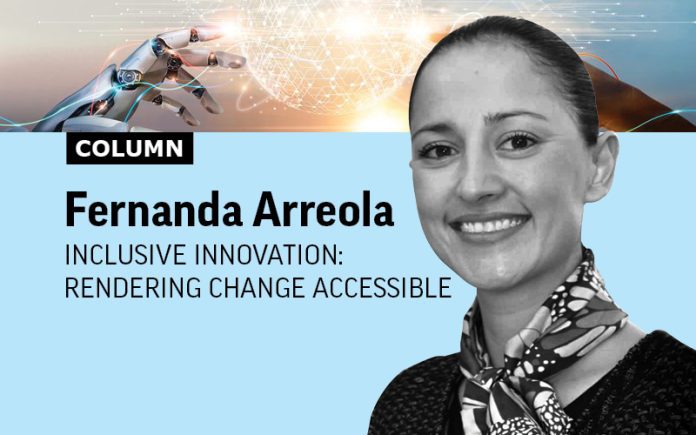By Gregory Unruh and Fernanda Arreola
The rapid adoption of AI in today’s organisations leaves workers with two choices: waste their energy in a futile attempt to stop it or support the technology and develop a personal perspective that makes them an asset in this evolution. This should be an easy choice to make!
Throughout history, technological waves have transformed society, challenging individuals to resist or adopt a decision that determines their fate.
For instance, when textile mills spread across Europe in the 18th century, craftsmen rioted against the machines that were displacing them. As a symbol of protest, they threw their wooden “Sabot” shoes into the mechanical workings and became the world’s first “saboteurs”. Despite their efforts, the machines proliferated, and manual labour was dramatically devalued.
Nearly one hundred years later, in the 19th century, another technology – photography – threatened the livelihoods of classically trained painters. Cameras simplified image reproduction with near-perfect realism and became a menace to the painters exhibiting in Paris salons. For some artists, however, the response was different. Instead of competing with the camera’s photorealism, painters leaned into something the camera did not have – a subjective interpretation that infused their work with emotional depth and personal perspective. By doing so, they gave birth to a new artistic movement: Impressionism.
As history repeats, we must ask ourselves a question. With the advent of Artificial Intelligence in today’s organisations, will we react like sabotaging 18th-century craftsmen or like impressionist painters in the 19th century?
Becoming an Impressionist
As professionals, we should all be concerned about optimally positioning ourselves in an era of accelerated technological change. Not only is technology moving faster, but so is our capacity to adapt and use it.
Contemplating the different responses of the 18th and 19th centuries craftspeople is helpful. Remember that both eras faced a common threat: a technology that produced faster and more consistently and could therefore replace what had been the sole domain of skilled workers.
But it is the response to that situation that matters. While saboteurs responded with outrage, Impressionists recognised the futility of confrontation. This leads us to the first key difference, dissociation. Impressionists leveraged human abilities beyond the camera’s reach; the ability to translate the world of subjective experience onto canvas. Instead of faithfully replicating the objective world, impressionists conveyed their as-lived experience, along with the emotions arising within, to capture the fleeting nature of human perception and existence.
Second, impressionists understood that there was no cherry-picking regarding technology and were motivated to leverage the advancements technology was bringing. For example, the evolution of oil pigments made it possible for painters to get out of the studio and experiment with the transient effects of natural light and colour in the portrayal of landscapes and everyday life.
Finally, impressionists explored how competing technologies, like photography, could enhance their artistic development. Learning from the science of photography, impressionists were able to use a wider variety of images and ideas from around the world, leading to more original creations. They also understood that, as when taking pictures, an artistic subject could extend beyond posed sets to include scenes from urban and suburban venues, enlarging their creative scope.
So, what can today’s professionals take from impressionism as we confront AI?
What is the knowledge worker’s analogue to an artist’s impressions?
In a word – perspective.
Perspective is the filter we use to understand the world, assess problems, and arbitrate for solutions. Perspective is a unique result of our accumulated knowledge, skills, relationships, and life experiences. Collectively, this makes us cognitively different – unique even – from others. This sometimes-undervalued asset is one of our greatest sources of differentiation in an emerging world of thinking machines that can challenge the professional class of knowledge workers.
But it is not all about thinking. Perspective also means tapping into our humanity, connections, and individual vulnerabilities. The “soft skills”, which are difficult for algorithms to replicate, are essential because of their inimitability. Revaluing our individual positioning in today’s technological turn is therefore essential. Like the impressionists, we can evade a frontal assault, and instead build our unique perspective as the foundation of our personal value proposition as we leverage Artificial Intelligence for our own expression.
Becoming a Professional Impressionist: Three Practices
Cultivate Your Unique Perspective
Artists cultivate a unique way of perceiving the world and develop an ability to evoke that perspective both cognitively and emotionally in others. Professional and public figures frequently traffic in their unique perspectives. Think of the author Malcolm Gladwell. He is often retelling known stories but crafting and sharing them in his unique way to serve his literary goals. Political candidates habitually publish a book to introduce their life experiences to the electorate and frame the perspective they will bring to the office. Transformational executives like Steve Jobs, Elon Musk and Bob Iger derive much of their vision from their perspective and their ability to share it in compelling ways.
We can all do this but we must cultivate the skill, and that begins by becoming clear about the value our personal story has wrought. What is unique and differentiating about you, beyond your training and expertise? Is it in your unique work or life experiences? Your work ethic or values? Your ability to forge group cohesion? Clarifying the unique perspective that differentiates you from others, and algorithms, is a powerful impressionist starting point.
Seek the Perspectives of Others
When leaning into your personal perspective, you must also be aware of its limitations. The world is too big and our brains are too small to capture the whole of reality. We only perceive a subjective sliver of the objective world we are immersed in. You can see this right now if you look. As you read, you only attend to a word or two at a time. The rest of the page is a peripheral blur. In that liminal perceptual edge are your unseen risks and opportunities. How can you access what you aren’t perceiving?
Because of our unique perspectives, other people are seeing a different slice of the world than you. To access their individual reality, you must become curious about the perspectival world in their head. It is here where the managerial power of the Diversity, Equity, and Inclusion movement lies. While DEI is inherently fair and can help overcome structural inequities, a managerial utility of DEI is bringing diverse perspectives into our organisational realm. Doing so allows us to “see” what is beyond our perceptual periphery. Those perceptual insights are there, but the only way you can access them is if the person chooses to disclose them to you. Cultivating curiosity in your colleagues’ perspectives and developing the interpersonal skills needed to elicit them is the next step in becoming a professional impressionist.
Master the Creation of Shared Perspectives
Something unique happens when we connect. You feel it. It enhances the experience of a scary movie. It’s why you prefer a live concert instead of listening to perfectly reproduced music through your Air Pods. It also happens at work. Not always, but sometimes, like when you are part of a team and have a feeling of shared purpose and accomplishment, it clicks. You are together, on a collective mission pursuing something worthwhile.
For now, only humans can create those feelings, not algorithms. A professional impressionist can become conscious of this collective, intersubjective realm and can learn to influence it. It’s the realm of engagement, motivation, ambition, excitement, loyalty, and other collective spirits. It is as much art as science, but those who master it often change the world. Gandhi, Malala, Mandela, Sirleaf, King, and others arguably changed their worlds, not through titular power and authority, but by mastering the ability to forge shared perspectives for change that motivated large swaths of the population. You may not need to change the world, but you can learn to cultivate shared perspectives among your community, tapping into both logic and inspiration in pursuit of shared goals.
For now, AI does not have access to human perspectives or human impressions. This makes personal perspective a durable point of differentiation for professionals in a rapidly changing digital workspace.
About the Authors
 Fernanda Arreola is a Professor of Strategy, Innovation, and Entrepreneurship at ESSCA and a researcher focusing on service innovation, governance, and social entrepreneurship. Fernanda has held numerous managerial posts and possesses a range of international academic and professional experience.
Fernanda Arreola is a Professor of Strategy, Innovation, and Entrepreneurship at ESSCA and a researcher focusing on service innovation, governance, and social entrepreneurship. Fernanda has held numerous managerial posts and possesses a range of international academic and professional experience.
 Dr. Gregory C. Unruh is the Arison Professor of Values Leadership at George Mason University. His most recent book is Strategy on the Sustainability Frontier (Global Leadership Academy Press, 2020).
Dr. Gregory C. Unruh is the Arison Professor of Values Leadership at George Mason University. His most recent book is Strategy on the Sustainability Frontier (Global Leadership Academy Press, 2020).


























